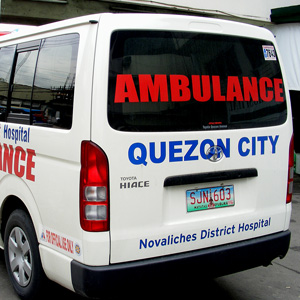A security guard walks through the office halls in the middle of his shift when he heard a commotion in the conference room some 20 feet away. Somebody cries, “Help, John just collapsed!” as he walks into the conference room and sees a man in his mid-40’s lying on his back beside the long oval table. There were three other employees in the room. Two of them were men, with confused and afraid looks on their faces, as the third tries to call out the patient’s name “John! John!” Upon initial observation the man is not responding and doesn’t seem to be breathing normally as well.
Situations like this might not be too far fetched a scenario in the work place. In fact, according to the Deparment of Health (DOH) the two leading causes of death for both males and females are diseases of the heart and diseases of the vascular system. In 2005, the DOH tabulated that “diseases of the heart” had a mortality rate of 90.4 per 100,000 population with a 5-year average of 83.3 mortality rate between 2000-2004.
(“Health Indicators”—Department of Health website: http://www.doh.gov.ph/kp/statistics/leading_mortality: June 29, 2009).
And indeed the need to enhance the skills of our first responders is even more imperative. New recommendations for Cardiopulmonary resuscitation (CPR) were released after experts met in the 2005 International Consensus of CPR and Emergency Cardiovascular Care (ECC) Science conference held in Dallas, Texas.
The most significant changes the 2005 CPR & ECC guidelines provided were not only of the ventilation-to-compression ratio for adults, children and infants but also the focus on encouraging “CHEST COMPRESSION-ONLY CPR” or more commonly referred to as the “Hands-only CPR”.
Ventilation-to-compression Ratio
The changes in the ventilation-to-compression ratio were the most obvious in the conduct of CPR after the 2005 ECC guidelines were released. Prior to 2005, compression rates were only 15 chest compressions followed by 2 rescue breaths (ventilation rate). This consists of one cycle and is repeated four times. With the current guidelines, chest compression rates were increased to 30 and it is now made easier to remember since it is standardized for adults, children and infants. The ventilation rate of two (2) rescue breaths remained the same, however the focus now with lay-person first responders is to deliver quality and effective chest compressions over rescue breathing. And this leads me to my next point.
Hands-only CPR
What this means for the lay person/first responder is that when he/she responds to a patient suffering from a sudden cardiac arrest emergency he/she may now choose NOT to give rescue breaths to the patient while providing CPR. In the past, I remember it was considered sacrilege not to give proper and perfectly executed rescue breaths during CPR. Current training guidelines now emphasize quality chest compressions and minimizing the interruptions in the delivery of chest compressions by the delay caused by ineffective rescue breathing. There are several reasons that may hinder the first responder in providing effective rescue breathing. Some of the examples that delay and interrupt chest compressions are:
- difficulty in opening the airway;
- difficulty in attaining a tight mouth-to-mouth or mouth-to-mask seal using ventilation barriers; and/or
- the lack of ventilation barriers.
For many, not having a ventilation barrier prevents them from doing CPR and providing care altogether. The new guidelines encourage lay persons to intervene and provide care to sudden cardiac arrest patients until professional emergency medical services arrive using hands-only CPR. And indeed “any care provided is better than no care at all” when responding to a medical emergency such as a patient experiencing a heart attack.
Going Back to Basics
By-stander/lay-person first responder intervention extends the window of time during which the patient may be successfully resuscitated by professional EMS providers. CPR is not the end-all and be-all in reviving a person experiencing a heart attack. All too often the patient needs defibrillation and/or advanced cardiac drugs that can only be provided by professional EMS providers. Providing chest compression-only CPR allows the rescuer to artificially pump the heart with oxygenated blood to supply the various vital organs of the body such as the brain. When the heart starts beating erratically (called ventricular fibrillation or the abnormal twitching of the heart) the brain is not getting enough supply of oxygen through the blood. Death of brain tissue can occur in as little as 4 to 6 minutes and permanent damage can occur beyond that timeframe. Thus early and effective by-stander/lay-responder intervention is very important in extending the chain of survival of the patient.
In the chain of survival, early access and recognition of the medical emergency by alerting EMS followed by prompt delivery of CPR and/or early application of an AED, if available, to a sudden cardiac arrest patient may all be done and provided by the by-stander/lay-person first responder. I once heard a prominent emergency doctor say that “paramedics saves lives and we all know that the basics saves the paramedic” and, indeed, the “basics” are composed of providing quality CPR and prompt application of an AED whenever available both by lay-person and professional first responders alike.
CPR and first aid certifications are valid and should be renewed every two years. But the skills should be refreshed as often as possible and is recommended especially for designated first responders. For more information on the 2005 CPR and ECC guidelines visit: http://www.emtb.com/9e/docs/ecsi_2005_matrix.pdf. •
Further reading
- Donovan & Abella, “Are Your CPR Skills Up to Speed? – Improving CPR and resuscitation care in the field”; EMS Responder: http://www.emsresponder.com/print/EMS-Magazine/Are-Your-CPR-Skills-Up-to-Speed/1$9042 (2009)
- “DOH Health Indicators: Leading Cause of Mortality”: http://www.doh.gov.ph/kp/statistics/leading_mortality (June 2009)
- American Heart Association: “Chain of survival”: http://www.americanheart.org/presenter.jhtml?identifier=3012016






